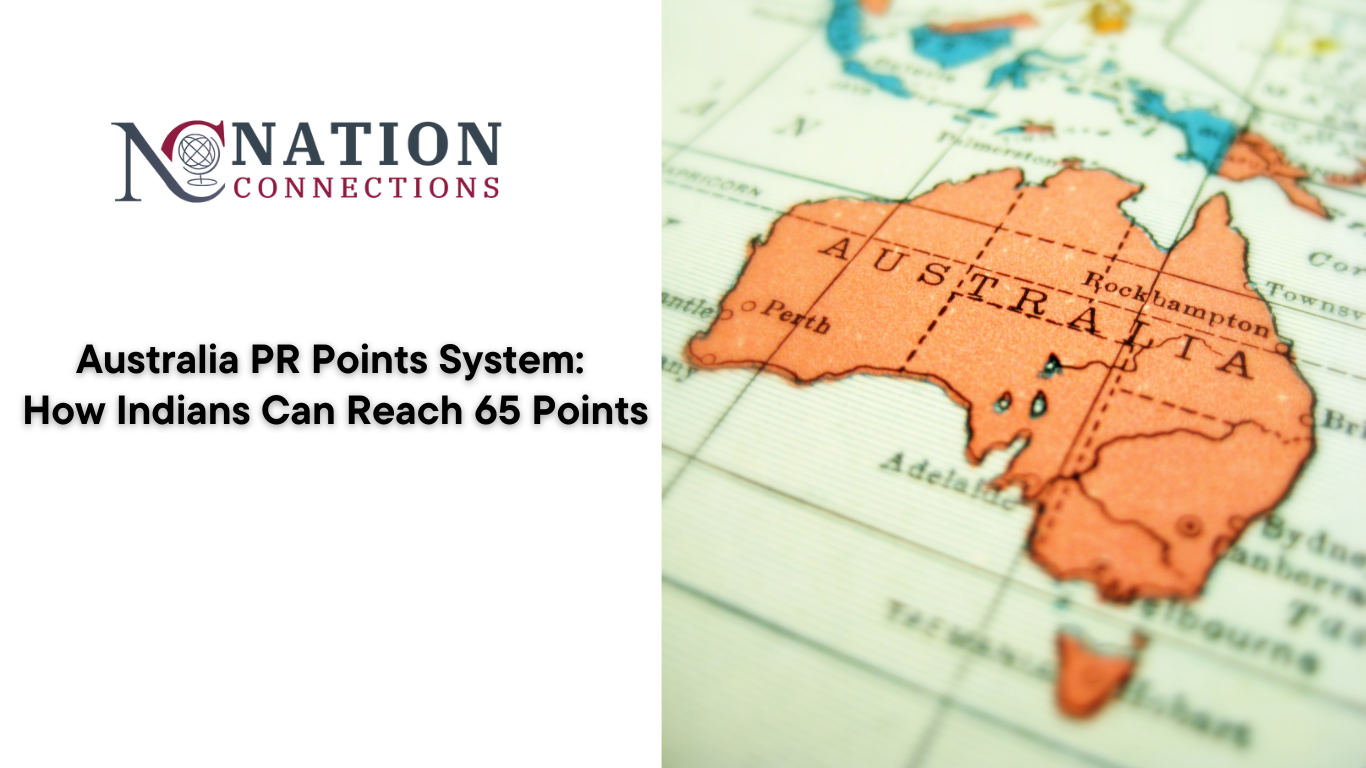
If you’re an Indian professional exploring the possibility of migrating to Australia, understanding the Skilled Migration Program’s points framework is crucial. The so-called Australia PR Points System determines whether you qualify for skilled migration visas such as the Subclass 189 (Skilled Independent), Subclass 190 (Skilled Nominated) or Subclass 491 (Skilled Work Regional). For many Indians, the magic number to aim for is 65 points — the minimum threshold to lodge an Expression of Interest (EOI) under the SkillSelect system. However, it’s important to realise: reaching 65 points makes you eligible to apply — it doesn’t guarantee an invitation. In many competitive occupations, you’ll need many more points to receive an Invitation to Apply (ITA).
In this blog we will:
Unpack the Australia PR Points System and how Indians can understand and calculate their score.
Walk you through each factor that earns points (age, English, education, work experience etc.).
Provide practical tips and “real-life” strategies for Indians aiming to hit 65 points (and ideally go beyond).
Highlight common pitfalls, and what you must do after scoring 65 points to strengthen your application.
Let’s dive in.
The Australia PR Points System is the method used by the Department of Home Affairs (DHA) to evaluate “skilled migration” applicants. Applicants for visas like Subclass 189/190/491 submit an EOI via the SkillsSelect system. Their eligibility is assessed via a points-test: you accumulate points across various criteria. If you score the required minimum (currently 65 points) you become eligible.
According to multiple sources, 65 points is the baseline threshold to lodge an EOI under the points-tested visas. But as noted, in reality competition is stiff: many invitations go only to those with 80-100 points or more.
Beyond just meeting 65 points:
Your profession (occupation code) must be on the relevant Skilled Occupation List (e.g., MLTSSL or STSOL).
You’ll need a positive Skills Assessment from the relevant assessing authority (e.g., ACS for IT, Engineers Australia etc.).
Once you submit the EOI, candidates are ranked by their points score; those with the highest get invited first. Hence the “higher the points, better your chances”.
Below is a detailed table of the main factors that contribute to your points. Note: values may change over time — always check latest official details.
| Factor | Possible Points | Important Notes (for Indians) |
|---|---|---|
| Age | Up to 30 points (25-32 yrs) | Best age band: 25-32 yrs (30 pts). After 40 you lose many points. |
| English Language Proficiency | Up to 20 points | Achieving “Superior English” (e.g., IELTS 8 each band) gives max points. For many Indians this is a big lever. |
| Overseas Skilled Employment (outside Australia) | Up to 15 points | Must be in nominated occupation (or closely related) and within last 10 years. |
| Australian Skilled Employment (in Australia) | Up to 20 points | Less relevant for many Indians who haven’t worked in Australia—but if you have, this can be a big boost. |
| Educational Qualifications | Up to 20 points | Doctorate gets highest, Bachelor/Master next. Considering up-skilling may help. |
| Other Points (each smaller value) | • Australian study requirement (2+ years) – 5 pts • Regional study/work or study in regional Australia – 5-15 pts • Credentialled community language (NAATI) – 5 pts • Partner skills – up to 10 pts • State nomination (190) – 5 pts; Regional sponsorship 491 – up to 15 pts |
Now let’s apply the above for Indian applicants and map a strategy you can follow.
Age: If you’re between 25-32 yrs you get full ~30 points. If older, fewer points.
Education: Do you have a Bachelor’s or Master’s? That gives ~15 points; a PhD gives ~20.
Work Experience: Do you have 3+ years overseas skilled work? Start counting.
English: Aim for high IELTS or PTE bands early.
Evaluate your current score. If you’re already at 50-55 points, you’re close.
Assume you currently have 50 points. You need a further 15 points to hit 65. Which levers can you use?
Improve English: If you currently qualify only for “Competent English” (0 points in the points table) → aim for “Proficient” (10pts) or “Superior” (20pts). This upgrade might give +10 or +20 pts.
Gain more work experience: For example, going from 3-5yrs overseas to 5-8yrs may increase your points from 5 → 10 or 10 → 15.
Upgrade your qualification: If you hold a diploma, consider converting to a Bachelor, or even a Master/PhD eventually. That can give +5 to +10 points.
Partner skills or NAATI language or other bonus factors: If your spouse has good English or skilled work you can claim partner skills pts. Also if you know a community language and get NAATI accreditation you can gain +5 pts.
State nomination or regional sponsorship: If you apply under Subclass 190 (state nominated) you can claim +5pts; under Subclass 491 (regional) you might get +15pts. This is a powerful route for Indians.
Say you are 29 yrs (30 pts), have a Bachelor’s (15 pts), overseas work 5yrs (10 pts), and you aim for “Proficient English” (10 pts). That gives you 30+15+10+10 = 65 points. If you then add a state nomination (+5) you reach 70 points which strengthens your chances.
Even though you may hit 65, you should aim for as many as possible. Why? Because:
Many occupations are competitive; invitations often go to 80 + points.
Lower-scoring applicants may wait longer in the pool or may not get an invite at all. For example:
“I would say for any IT occupation you would need 90 points for a 189 invitation.”
So treat 65 as “entry-gate” but not the target-finish line.
Get a positive Skills Assessment in your occupation.
Take IELTS/PTE/TOEFL and aim for high bands to unlock full points.
Accumulate more years of skilled work (document properly).
If possible, study/complete a degree in Australia (2+ years) or complete a Professional Year program.
Explore state-nomination routes (190) or regional routes (491) for bonus points.
Consider partner’s skills, knowledge of a community language (NAATI) etc.
Submit your EOI via SkillSelect once you are confident you have 65+ points.
Maintain flexibility and monitor the occupation list and invitation rounds for your profession.
Since you’re based in India (like many Indian professionals), here are some tailored insights:
Occupation list: Make sure your occupation (as assessed by the relevant authority) is on the Skilled Occupation List for 189/190/491. Some Indian professions may face delays or changes.
English language: Indians often excel in English but to maximise points you need top bands (e.g., IELTS 8 each). Many coaching institutes in India specialise in this.
Work experience proof: Ensure your employment is properly documented (references, months, duties) because skills-assessment bodies in Australia scrutinise this.
Cost & timeline: Studying in Australia or doing a Professional Year program is expensive and time-consuming — factor this into your strategy.
State nomination/regional routes: Some Australian states actively seek skilled migrants. Indian applicants should explore which states have demand for their skills.
Age factor: Since age points decline after 32-33 years (and drop significantly after 40) it’s wise not to delay too long.
Competition from other countries: You’ll be competing with applicants worldwide; hence higher points give you an edge.
Myth: “As soon as I reach 65 points I’ll get a visa.” Not true. 65 points makes you eligible to be invited to apply, but does not guarantee an invitation.
Pitfall: Not verifying the correct skills assessment authority for your occupation — this can cause major delays or refusal.
Myth: “If I apply via 491 (regional) I’ll automatically get PR.” No — you still need to meet criteria, and after the regional visa you may need to work for a period before becoming eligible for permanent residency.
Pitfall: Relying solely on age or education for points and forgetting to strengthen English or work experience, which can be critical differentiators.
Pitfall: Ignoring costs/taxes of migration, or overlooking the fact that migration is not just about getting PR but also about adapting to living/working in Australia (culture, cost of living, job market).
What is the minimum points required for Australia PR (skilled migration)?
The minimum threshold to submit an Expression of Interest is 65 points under the points-tested visa stream.
Does achieving 65 points guarantee that I’ll get an invitation to apply?
No. While 65 points makes you eligible, you will only receive an invitation if your occupation is in demand and your score is competitive among other applicants. Many invitations go to those with 80-100+ points.
Which visa subclasses use the points-test?
Key subclasses are: 189 (Skilled Independent), 190 (Skilled Nominated), and 491 (Regional Skilled Work). Each uses the points-test though 190/491 may have additional requirements (state nomination, regional sponsorship).
How can I maximise my English language points?
Aim for “Superior English” results (e.g., IELTS 8 or equivalent) to attain the highest English‐language points (up to 20). Preparing and practising the exam properly is essential.
For Indian applicants, which factors are the easiest to improve?
English test score, gaining extra years of work experience, enrolling in higher qualification, and exploring state/region nomination routes are often the most practical levers.
What if I’m older than 40 years? Can I still apply?
Yes, you can apply if you meet other criteria; however, age points drop significantly after about 40, so you’ll need to compensate via other factors (e.g., strong English, high qualification, nomination).
The Australia PR Points System provides a transparent and systematic way for skilled migration to Australia. For Indian applicants, reaching 65 points is a vital milestone — it opens the door to submitting an EOI. But remember: in today’s competitive landscape, 65 points is just the starting line, not the finish. Aim higher. Strengthen your English, build relevant work experience, pursue recognised qualifications, and explore nomination/regional pathways to boost your score into the 80s or 90s. If you plan strategically, you can turn your migration ambition into reality.
Best of luck with your journey!



